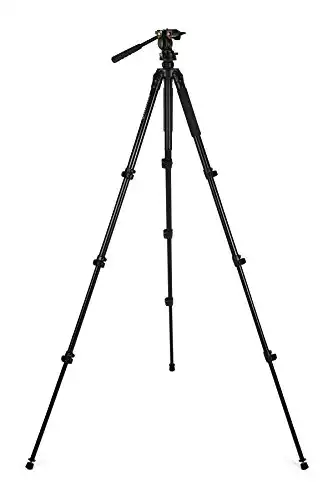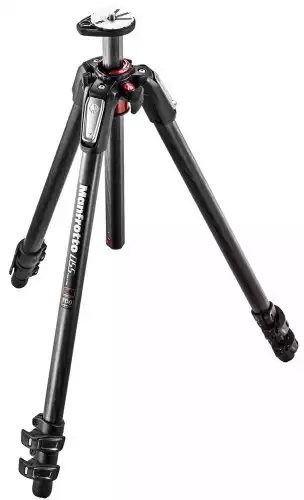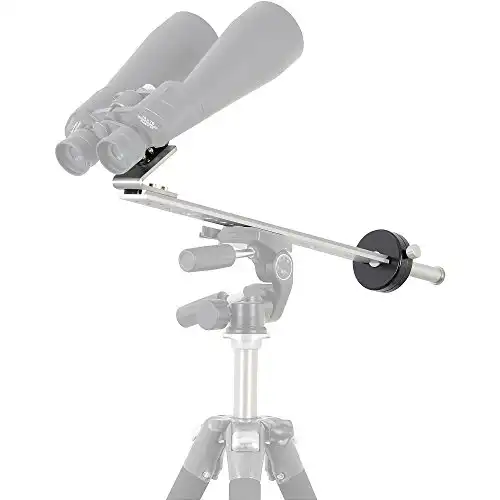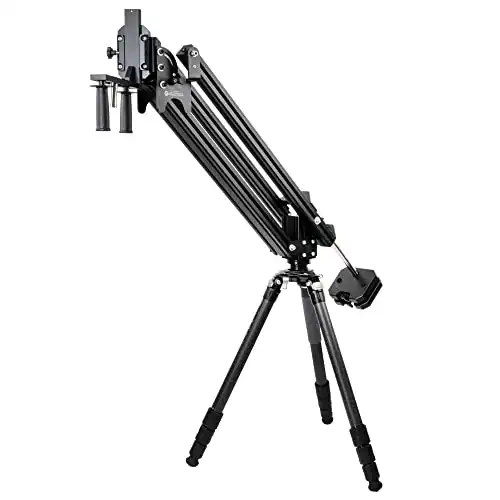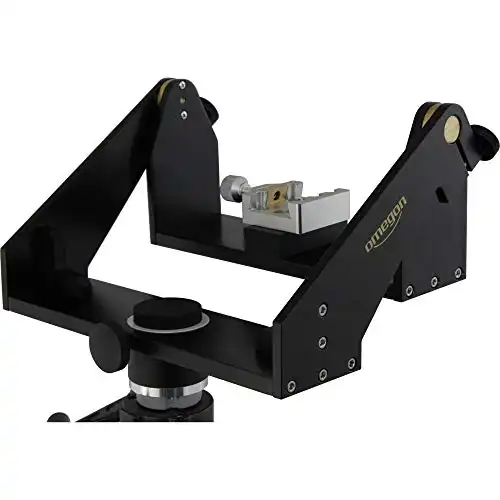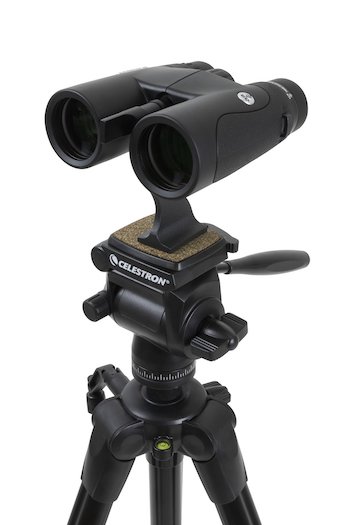Large astronomy binoculars (more than 10x magnification) need to be used with a tripod. This is because using them by hand will result in:
- Considerable shakiness that will ruin your observations
- Heaviness after just a few minutes
You can attach astronomy binoculars to any regular photography tripod.
Most larger models have an in-built adaptor so they screw straight on. With others you may need to buy an adaptor for this (which are usually inexpensive).
However, there are also a few challenges with using astronomy binoculars attached conventionally on regular tripods:
- It will likely require you to stoop when viewing. For example, if you are 6ft (182cm) tall, then your tripod would need to be taller than this as the eyepiece will be lower than the maximum height of the tripod when the binoculars are pointing up at the night sky.
- If you bypass this by having a really tall tripod then you will likely encounter some unsteadiness, as any tripod will become more unsteady the longer the legs are extended.
- If you then try to bypass this by having them lower and sitting in a chair you will likely find that the tripod legs will get in the way of the chair and it can be hard to find a comfortable position that you would be happy to stay in for any length of time.
The best solution overall then is to combine a good sturdy tripod with a specific binocular mount.
The mounts that we recommend here allow your binoculars to be positioned lower and further from the center of your tripod.
This allows you more scope to find a comfortable position to use your astronomy binoculars either standing or sitting.
See the quick links in the table below, or read on for more detailed reviews and recommendations.
|
Make & Model:
Celestron Regal Premium
|
Make & Model:
Manfrotto 3-Section Carbon Fiber Tripod
|
Make & Model:
Omegon Binocular Mount
|
Make & Model:
Omegon Pro Kolossus Mount
|
Make & Model:
Omegon Fork Mount for Large Binoculars
|
|
Load capacity:
8.8 lbs
|
Load capacity:
20 lbs
|
Load capacity:
5.5 lbs
|
Load capacity:
11 lbs
|
Load capacity:
26 lbs
|
|
Weight:
6 lbs
|
Weight:
4.4 lbs
|
Weight:
1.5 lbs
|
Weight:
38.5 lbs
|
Weight:
8.6 lbs
|
Best Tripods for Binoculars
Celestron Regal Premium Tripod
Best Budget Tripod for Astronomy Binoculars
The Regal Premium is the sturdiest Celestron binocular tripod and is suitable for all models of Celestron SkyMaster binoculars.
It has a load capacity of 8.8 lbs which is enough for any pair in the SkyMaster range, with the heaviest pair (the 25×100) weighing 8.75 lbs.
The aluminum legs and 6 lbs tripod weight ensure good stability for night sky binocular observing – this is where it beats the Celestron Trailseeker and Ultima binocular tripods (see below). There is also a balance hook underneath that allows you to add weight if required.
It has a two-way fluid pan head which is very easy to use, with a single handle to direct the binoculars where you want them to point.
The quick-release plate makes it easy to attach binoculars and has a safety mechanism to prevent them from sliding out unintentionally.
Pros
- Heavy and sturdy
- Tall at 69 inches
- Easy to use pan handle
- Good load capacity at 8.8 lbs
- A high quality quick release mount
- Can be used with your a spotting scope or your camera
- Made by Celestron, many people’s preferred manufacturer of astronomy equipment
Cons
- Even at 69 inches the height many will have to stoop to look through their binoculars when pointing up which is an obstacle to longer viewing sessions
- The heaviness may be a problem if you need your tripod to be portable
- Lower weight capacity and more expensive than the Orion Tritech tripod above
Key specifications
- Material: Aluminum
- Mount: Two-Way Fluid Pan Head
- Payload Capacity: 8.8 lbs (4 kg)
- Weight: 6 lbs (2.7 kg)
- Height: 69 inches (1.75 m)
- Included accessories: Case and shoulder strap
There are a couple of other Celestron binocular tripods that are worth knowing about if thinking about buying the model above – the Trailseeker and the Ultima:
Celestron Trailseeker Tripod
The Trailseeker is very similar to the Regal Premium tripod outlined above – it is virtually the same height and has the same load capacity. It is also usually cheaper.
What sets it apart is that it weighs significantly less (less than 4 lbs). You may consider this an advantage if you are planning to travel with it frequently, but the extra weight of the Regal Premium Tripod effectively gives it extra stability, which you will value when trying to view far-off astronomical objects.
This is why we primarily recommend the Regal Premium over the Trailseeker for astronomy binoculars.
Celestron Ultima Tripod
Similar to the Trailseeker, the Ultima tripod has the same pros and cons – it has the same weight capacity and very nearly the same height. It is also usually the cheapest Celestron tripod.
Again though, it is a more lightweight model at just 4.7 lbs and this will be a disadvantage when looking for stability in a tripod for astronomy binoculars.
Manfrotto Carbon Fiber Tripod
Best Premium Tripod for Astronomy Binoculars
With the tripod, it is simply the case of the sturdier the better. Carbon fiber tripods tend to be slightly better as:
- They absorb vibration better
- Carbon fiber tripods tend to be lighter than aluminum ones on a pound-for-pound basis with regard to payload capacity.
We recommend this model as:
- Manfrotto are renowned as the best tripod makers in the world
- It is carbon fiber
- It has a high payload capacity (9 kg / 20 lbs)
- It is light and packs up compactly for good portability
- It is tall at 67-inch / 170cm
On the downside, it is more expensive than an aluminium model of similar specs.
3-Section Carbon Fiber Tripod
- 67-inch (170cm) height
- The carbon fiber material is ultra-light but strong
- Manfrotto's Q90 center column boasts quick one finger operation
Best Astronomy Binocular Mounts
We recommend two great options at different ends of the price spectrum.
Firstly, this Omegon mount will work well with astronomy binoculars of up to 5.5 lbs weight.
This would include any of these popular (and highly recommended models):
- Celestron SkyMaster 15×70 – 3 lbs
- Celestron SkyMaster 25×70 – 3.3 lbs
- Celestron SkyMaster 20×80 – 4.7 lbs
Tripod mount for astronomy binoculars
- 5.5 lbs load capacity
- 1.5lbs weight
If you have larger binoculars though (like the Celestron SkyMaster 25×100 at 8.8 lbs or even bigger) then we would recommend this premium mount with a higher payload capacity.
It is a parallelogram mount that allows your binoculars to hang over one side of the tripod whilst being supported by counterweights.
The binoculars can then be positioned as low or as high as you want and means you can sit or stand comfortably when viewing – i.e. the tripod legs are not in the way of your chair.
This design lets you raise and lower the binoculars whilst staying focused on a specific object. This is a pretty cool feature and means that you can share the viewing experience with other people more easily. For example, you can view at your chosen height and find an object and then lower to allow a family member, friend, or person at a star party to look through.
It allows you to have the binoculars high, so perfect for tall people to use when standing without having to stoop.
The downsides are the higher price and also the increased weight.
Parallelogram mount for large astronomy binoculars
- 11 lbs load capacity
- 38.5 lbs weight
Fork mounts are great for when your binoculars are too heavy for being held by the regular attachment to a tripod head.
However, they do not allow your binoculars to be positioned away from the center of the tripod/mount like a parallelgram mount does.
The pros through are that they are much smaller and easier to use.
Astronomy Binocular Fork Mount
- 26 lb (12 kg) payload capacity
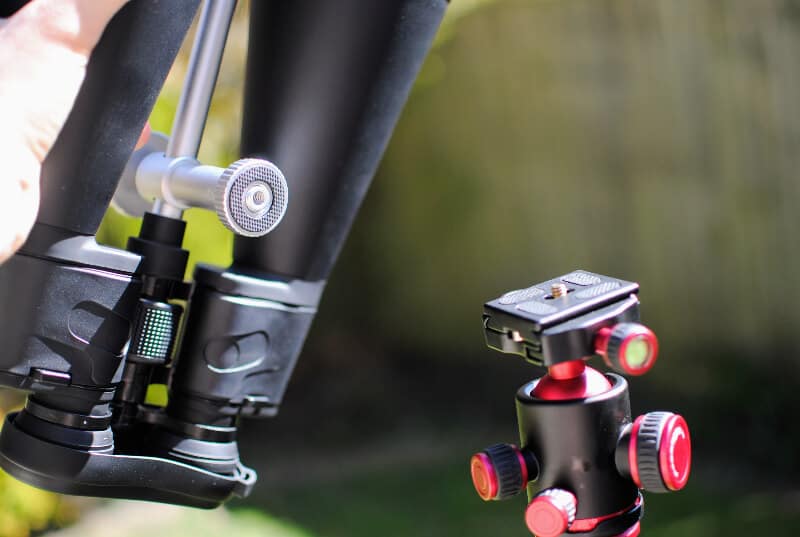
What to look for in an Astronomy Binocular Tripod
The main things to consider when choosing a tripod for binoculars is:
- Weight capacity
- Mount type
- Height
Binocular Weight
The first thing you should do when deciding which tripod is right for your binoculars is to check how much your binoculars weigh so that you can get a tripod with sufficient payload capacity.
You can check the weight of all Celestron SkyMaster binoculars here on Celestron’s site, for example:
- Celestron SkyMaster 15×70 – 3 lbs
- Celestron SkyMaster 25×70 – 3.3 lbs
- Celestron SkyMaster 20×80 – 4.7 lbs
- Celestron SkyMaster 25×100 – 8.8 lbs
Binocular Tripod Weight Capacity Comparison Chart
Of the binocular tripods that we recommend in this article, their weight load capacities can be seen in this comparison chart:
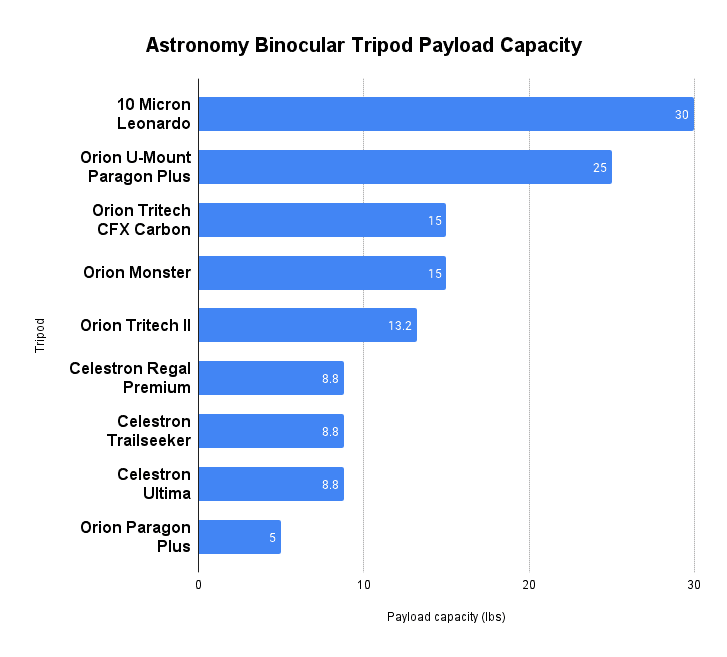
As you can see, some of the smaller tripods will not be suitable for bigger binoculars.
Tripod Mount Type
The second thing to consider is the mount type. There are three options:
- Pan head: These are the simplest to use and are what most people use with a camera on a tripod. With the handle you just point your binoculars where you want to look. The Orion Tritech and Celestron Regal are examples of this.
- Parallelogram: These are more complex and cumbersome but are specifically designed for astronomy binoculars to allow them to hang away from the tripod legs so you can stand or sit comfortably for long periods. The Orion Paragon Plus and 10 Micron BM100 are examples of this.
- Fork: These are easier to use but do not give the freedom that a parallelogram mount does. The Orion U-Mount Paragon Plus is an example of this.
If you have a good camera tripod already, you can always buy a mount separately.
Tripod Height
The third thing to consider is the height at which you will need your binoculars to be for comfortable viewing.
Since when stargazing you are likely to want longer sessions, you need your astronomy binoculars to be at a height that is comfortable for your neck and back. You may want to stand or you may want to sit in an astronomy chair.
Parallelogram mounted tripods give you the biggest range of heights here but you may find the pan head or fork mount tripods are tall enough for you.
Other factors when choosing binocular tripods
Other than these three things it is also worth considering:
- Weight and size: Some of these binocular tripods are very heavy, large, and bulky. You need to think about where you will use and store them.
- Material: Most of these tripods are aluminum. This material is heavier than carbon fiber which can make the tripod less portable but actually adds to the natural stability and sturdiness. Carbon fiber tripods are great if you will be looking to travel with them.
- Cost: Some of these tripods are less than $100 and some are in the thousands so think about your budget and how much you want to spend.
Best Tripod for Binoculars FAQs
Do I need a tripod for my binoculars?
The general rule is that if binoculars have a magnification of more than 7x then they should be used with a tripod rather than handheld. This is because the shake becomes too much at higher magnifications and it is hard to stay focused on far-off objects.
Astronomy binoculars can also be fairly heavy so not having a tripod will be an obstacle to long viewing sessions.
How to attach binoculars to a tripod? Do I need an adapter?
Some astronomy binoculars come with an in-built tripod adapter that will affix to any standard camera tripod. For other models, you will need to buy a separate adapter.
Should I use a tripod or a monopod with my binoculars?
For astronomy, a tripod will nearly always be best since you are often going to want to stay still and focused on a specific night sky object.
The only time a monopod would be good would be if you were moving around a lot (say, on a hike) and wanted to quickly plant your binoculars down to look through before moving again.
Do I need to match the binocular brand with the tripod?
No, you can use astronomy binoculars with any tripod. Just check that you have the right adapter.
Can you use a camera tripod for binoculars?
Yes, you can just attach them to a regular pan-head camera tripod. You can also buy specific binocular mounts separately and use them with other tripods if they can take the weight.
See the Best Camera Tripods for Astrophotography for recommendations.
What’s the best tripod for Celestron Skymaster 15×70, 25×70, 20×80 & 25×100 binoculars?
The Celestron Skymaster 15×70, 25×70, and 20×80 are all sub-5 lbs and so can be used with any of the tripods on this list.
The 25×100 model is heavier and will need a tripod with at least 8.8 lbs capacity.
What about using sitting?
Some also like to skip the tripod and use handheld whilst sitting in a reclining chair (and there are specifically-designed “observing chairs” for this). But this is best for smaller handheld astronomy binoculars like 7×50 or 10×50.
Further Information
If you don’t yet have a pair of binoculars then check out our article on the Best Binoculars for Astronomy or watch the video:
We also have a review of the Celestron SkyMaster 20×80 binoculars, and a video on this:
Further content can be found in our Astronomy Binoculars hub.



